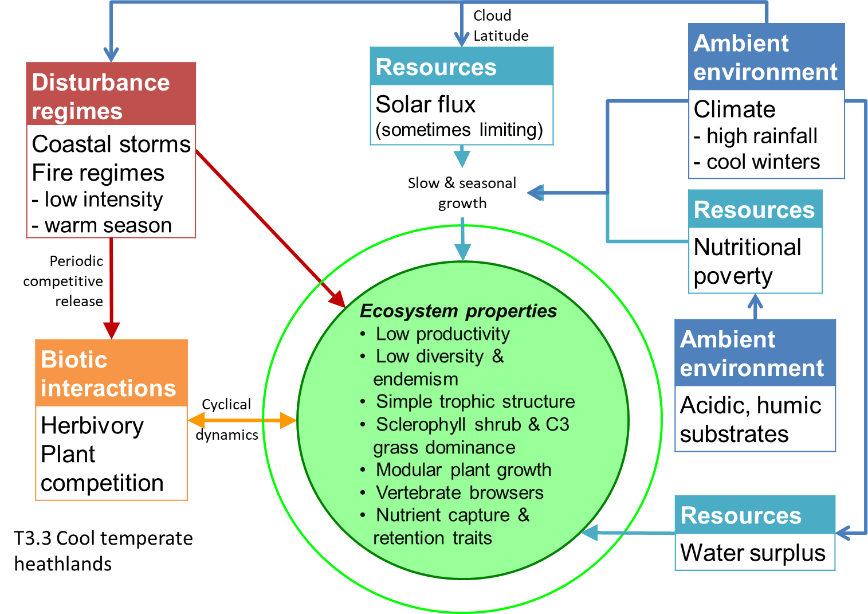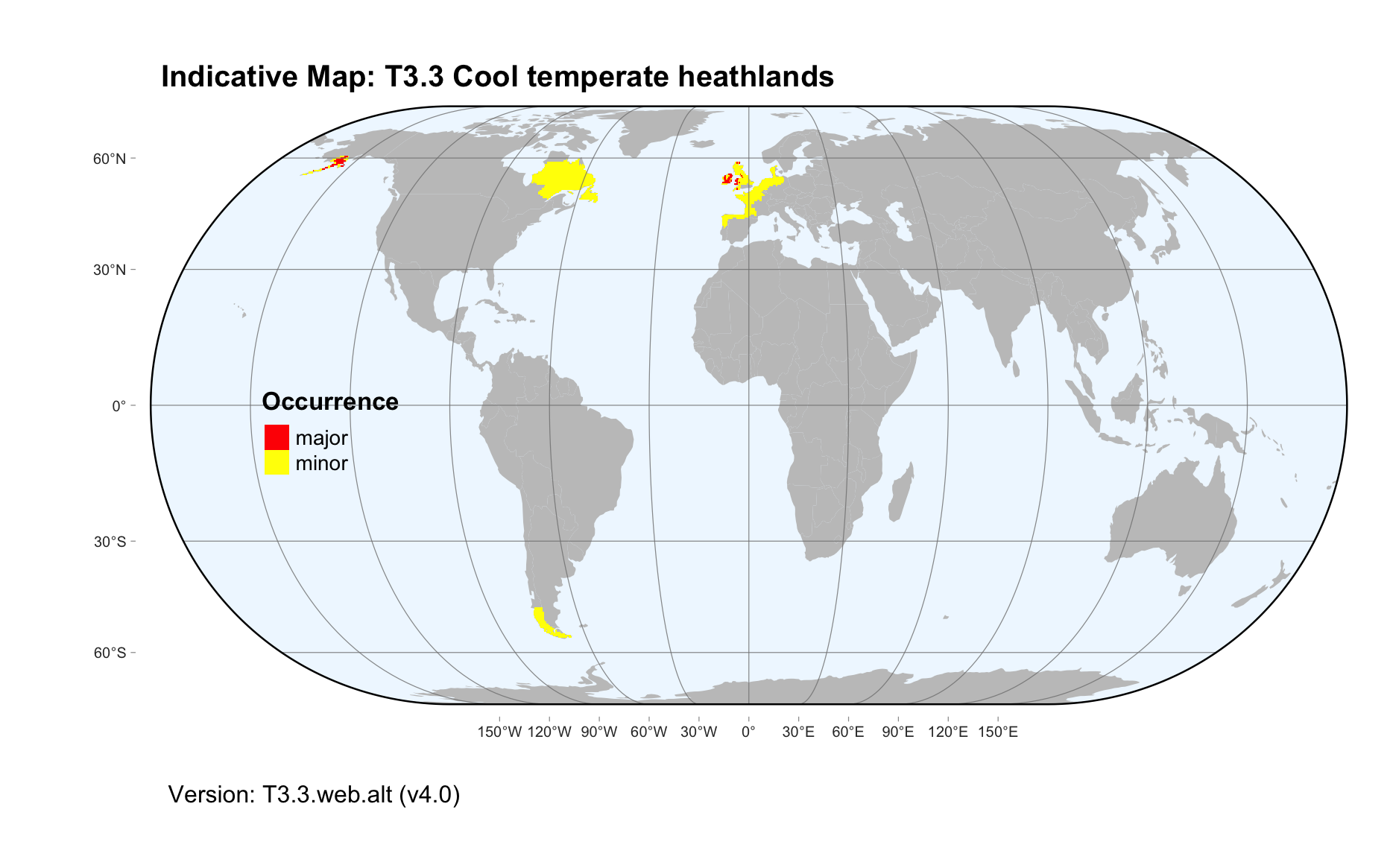Global ecosystem typology
Alternative site for the Global ecosystem typology with additional information for ecosystem profiles and indicative maps.
This site is maintained by jrfep
T3.3 Cool temperate heathlands
Biome: T3. Shrublands and shrubby woodlands biome
Contributors:
(texts)
In cool temperate, humid, maritime environments, a dense cover of low shrubs with small tough leaves is interspersed with grasses and ferns. Cold temperatures and low-fertility acid soils limit productivity, with wet subsoils limiting decomposition so that organic matter accumulates. Low intensity fires may occur in the warmer months. Browsing mammals, such as rabbits and deer, bring nutrients from more productive systems and maintain the shrubby composition. Canids and raptors are common predators of ground-nesting birds and rodents, in a relatively simple foodweb.
Key Features
Low-diversity, low productivity mixed graminoid ericoid shrublands of maratime environments, supporting mammalian browsers.
Overview of distribution
Boreal and cool temperate coasts, North America, Europe, Magellenic South America.
Profile versions
- v1.0 (2020-01-20): DA Keith; F Essl; NA Brummitt
- v2.0 (2020-07-03): DA Keith; F Essl; NA Brummitt; J Loidi
- v2.01 ():
- v2.1 (2022-04-06): DA Keith; F Essl; NA Brummitt; J Loidi Full profile available at official site
Main references
Selected references for this functional group:
Aerts R, Heil GW (1993) Heathlands: patterns and processes in a changing environment Kluwer Academic Publishing
Loidi J, Biurrun I, Juan Antonio Campos JA, García-Mijangos I, Herrera M (2010) A biogeographical analysis of the European Atlantic lowland heathlands Journal of Vegetation Science 21(5): 832–842 DOI:10.1111/j.1654-1103.2010.01204.x
Watt AS (1947) Pattern and process in the plant community Journal of Ecology 35, 1-22.
Diagrammatic assembly model

Maps
Maps are indicative of global distribution patterns are not intended to represent fine-scale patterns. The maps show areas of the world containing major (coloured red) or minor occurrences (coloured yellow) of each ecosystem functional group. See general notes on maps.
There are 2 alternative versions of the indicative map for this functional group, please compare description and sources below.
T3.3.IM.alt_v4.0
Datasets
- Resolve-Ecoregions-2017
- Landcover-North-America-2016
- Pisos-Vegetacion-Chile-2006
- EarthEnv-LandCover-v1.0
- Ecoregions-North-America-1997
Map references
Dinerstein E, Olson D, Joshi A, Vynne C, Burgess ND, Wikramanayake E, Hahn N, Palminteri S, Hedao P, Noss R, Hansen M, Locke H, Ellis EE, Jones B, Barber CV, Hayes R, Kormos C, Martin V, Crist E, Sechrest W, Price L, Baillie JEM, Weeden D, Suckling K, Davis C, Sizer N, Moore R, Thau D, Birch T, Potapov P, Turubanova S, Tyukavina A, de Souza N, Pintea L, Brito JC, Llewellyn Barnekow Lillesø JP, van Breugel P, Graudal L, Voge M, Al-Shammari KF, Saleem M (2017) An Ecoregion-Based Approach to Protecting Half the Terrestrial Realm, BioScience 67: 534–545. DOI:10.1093/biosci/bix014. Data-set available on-line
Latifovic, R., Homer, C., Ressl, R., Pouliot, D., Hossain, S.N., Colditz, R.R., Olthof, I., Giri, C., Victoria, A. (2016) North American land change monitoring system Remote Sensing of Land Use and Land Cover: Principles and Applications Giri, C. (Ed). CRC-Press, pp. 303-324 DOI:10.1201/b11964
Luebert, F. and Pliscoff, P. (2006) Sinopsis bioclimática y vegetacional de Chile. Editorial Universitaria. Santiago de Chile.
Tuanmu, M.-N. and W. Jetz (2014) A global 1-km consensus land-cover product for biodiversity and ecosystem modeling Global Ecology and Biogeography 23(9):1031–1045 DOI:10.1111/geb.12182
Commission for Environmental Cooperation (1997) Ecological Regions of North America – Toward a Common Perspective Montréal, Québec, Canada; 1997. PDF
T3.3.web.alt_v4.0

Datasets
- EarthEnv-LandCover-v1.0
- Resolve-Ecoregions-2017
- Landcover-North-America-2016
- Ecoregions-North-America-1997
Map references
Tuanmu, M.-N. and W. Jetz (2014) A global 1-km consensus land-cover product for biodiversity and ecosystem modeling Global Ecology and Biogeography 23(9):1031–1045 DOI:10.1111/geb.12182
Dinerstein E, Olson D, Joshi A, Vynne C, Burgess ND, Wikramanayake E, Hahn N, Palminteri S, Hedao P, Noss R, Hansen M, Locke H, Ellis EE, Jones B, Barber CV, Hayes R, Kormos C, Martin V, Crist E, Sechrest W, Price L, Baillie JEM, Weeden D, Suckling K, Davis C, Sizer N, Moore R, Thau D, Birch T, Potapov P, Turubanova S, Tyukavina A, de Souza N, Pintea L, Brito JC, Llewellyn Barnekow Lillesø JP, van Breugel P, Graudal L, Voge M, Al-Shammari KF, Saleem M (2017) An Ecoregion-Based Approach to Protecting Half the Terrestrial Realm, BioScience 67: 534–545. DOI:10.1093/biosci/bix014. Data-set available on-line
Latifovic, R., Homer, C., Ressl, R., Pouliot, D., Hossain, S.N., Colditz, R.R., Olthof, I., Giri, C., Victoria, A. (2016) North American land change monitoring system Remote Sensing of Land Use and Land Cover: Principles and Applications Giri, C. (Ed). CRC-Press, pp. 303-324 DOI:10.1201/b11964
Commission for Environmental Cooperation (1997) Ecological Regions of North America – Toward a Common Perspective Montréal, Québec, Canada; 1997. PDF
Check: the Glossary / Profile structure / the public document